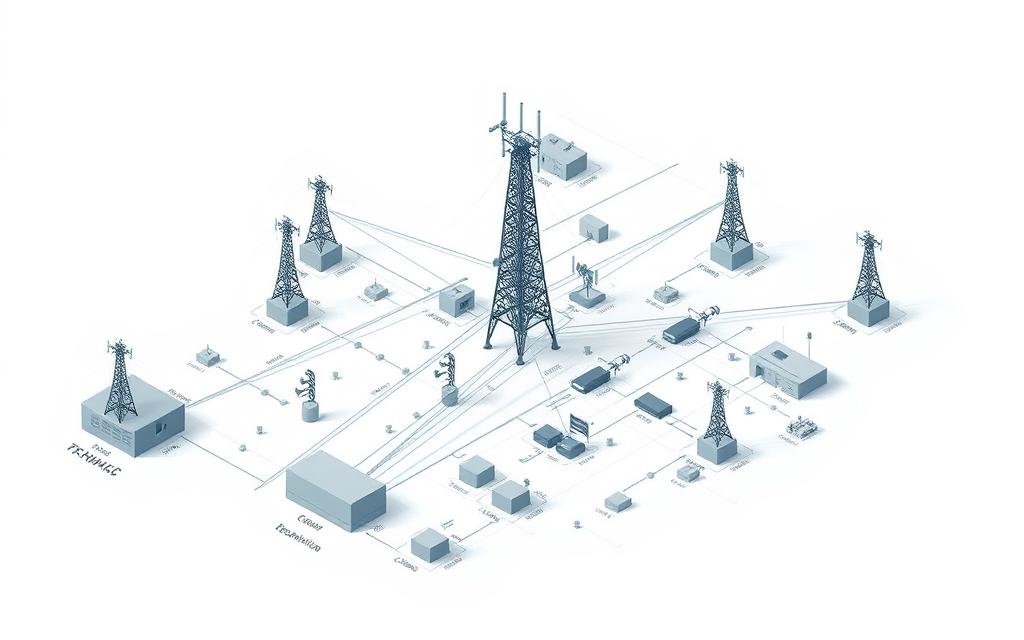Modern connectivity relies on invisible forces that shape our daily interactions. At its core, wireless communication principles depend on the controlled use of the electromagnetic spectrum – the same energy band that carries sunlight and radio broadcasts. This system enables devices to exchange information without physical links, from smartphone messaging to satellite navigation.
Engineers generate signals using oscillators, which create precise frequencies within designated spectrum ranges. These vibrations travel as radio wave propagation patterns, radiating outward through antennas. The Federal Communications Commission (FCC) manages spectrum allocation in the United States, ensuring different services – from emergency broadcasts to mobile networks – operate without interference.
Practical applications demonstrate these concepts clearly. When making a mobile call, voice data converts into digital formats through digital signal transmission techniques. The processed information then rides specific frequency bands to cell towers, often covering miles through carefully calculated signal paths. Satellite systems extend this reach further, bouncing microwaves between orbiting stations and ground receivers.
Understanding these mechanisms helps explain why some connections remain stable while others falter. Physical obstacles, competing frequencies, and transmission distances all influence the reliability we experience daily. As networks evolve, the fundamental physics of energy manipulation continues driving innovation in global communication systems.
Foundations of Wireless Communication
Wireless technology uses invisible forces to connect us. To understand how devices talk without cables, we need to know about electromagnetic energy and hardware.
Understanding Electromagnetic Waves
The RF spectrum allocation is key to wireless systems. It decides how different frequencies are used. Radio waves carry information through the air and space, from Wi-Fi routers to mobile networks.
Radio frequencies and their role in data transmission
The electromagnetic spectrum has bands for different uses:
- 2.4GHz: Used in household items like microwaves and older Wi-Fi routers
- 5GHz: Faster speeds with less interference in newer networks
- mmWave: Fast 5G in busy cities
Regulators assign frequency ranges to avoid signal conflicts. The ISM band lets devices like Bluetooth headphones work without a licence.
Modulation techniques: AM vs FM
Modulation methods change how information is carried on carrier waves. Here’s a comparison:
| Feature | Amplitude Modulation | Frequency Modulation |
|---|---|---|
| Data Encoding | Changes wave height | Changes wave frequency |
| Noise Resistance | Low | High |
| Modern Uses | Aviation radio | DAB radio broadcasting |
AM was early radio’s choice, but FM’s clarity won for music. Now, wireless systems often use digital methods like OFDM for Wi-Fi 6.
Key Components in Wireless Systems
Wireless tech needs special hardware to work well. Three parts are key for sending and receiving signals.
Transmitters: Converting data into radio signals
These devices turn electrical signals into electromagnetic waves. They use:
- Oscillators to create carrier waves
- Modulators to add data
- Power amplifiers to make signals stronger
Receivers: Decoding electromagnetic waves
Receivers do the opposite of transmitters. They:
- Catch radio signals with antennas
- Filter out unwanted signals
- Demodulate to get the original data
Antenna design principles
Antenna performance is based on three things:
| Characteristic | Impact | Example |
|---|---|---|
| Length | Decides resonant frequency | ¼ wavelength dipoles |
| Gain | Makes radiation pattern stronger | Directional Yagi arrays |
| Polarisation | Changes signal direction | Circular (satellite dishes) |
Today’s smartphones use many antennas to stay connected while moving. This shows how design meets user needs.
How Wireless Technology Works: Core Mechanisms
Modern wireless systems need careful engineering to keep connections strong. This part looks at how signals move and how data is turned into something we can send.

Signal Propagation Fundamentals
Radio waves act differently in different places. In cities, tall buildings cause multipath transmission. This means signals bounce off buildings, leading to Rayleigh fading. But, in the countryside, signals travel straight, with fewer obstacles.
Line-of-sight vs multipath transmission
In open areas, like when satellites talk to Earth, line-of-sight works best. But cities make signals split into many paths. This makes it hard for signals to get through walls, which is why 5GHz Wi-Fi struggles more than 2.4GHz.
Attenuation and signal degradation factors
Four main things weaken wireless signals:
- Free-space path loss: Signals lose energy as they travel
- Weather, like rain, can affect signals
- What buildings are made of matters
- Diffraction scattering happens when signals hit curved surfaces
Digital Encoding Methods
To send information, we need to change it into signals. Modern tech uses binary to turn voice, video, and text into electrical pulses.
Binary data conversion techniques
There are a few ways to do this:
| Technique | Modulation Type | Data Rate |
|---|---|---|
| QPSK | Phase-shift keying | 2 bits per symbol |
| 16-QAM | Amplitude/phase hybrid | 4 bits per symbol |
| 64-QAM | High-density modulation | 6 bits per symbol |
Error correction protocols
To keep signals clear, we use:
- Forward Error Correction (FEC) – adds extra data bits
- Automatic Repeat Request (ARQ) – sends bad packets again
- Hybrid ARQ – uses both methods
These help fight off interference, keeping messages clear even in tough conditions.
Modern Wireless Technologies Compared
Today, we have many wireless options for both home and mobile use. This section looks at three main types, comparing them through numbers and real-life examples.
Wi-Fi Standards: From Speed to Efficiency
Modern routers like the Netgear Nighthawk AX12 and Cisco Catalyst 9800 show Wi-Fi’s growth. They focus on handling many devices well and saving energy.
802.11ac vs Wi-Fi 6 Performance Metrics
Channel bonding and spatial streams are key, but Wi-Fi 6 brings new features. OFDMA splits channels into smaller parts, letting many devices send data at once.
| Feature | 802.11ac | Wi-Fi 6 |
|---|---|---|
| Max Speed | 3.5 Gbps | 9.6 Gbps |
| Frequency Bands | 5 GHz | 2.4/5/6 GHz |
| MU-MIMO | 4×4 | 8×8 |
| OFDMA Support | No | Yes |
| Latency | 30ms | 10ms |
Mobile Networks: The 5G Revolution
4G focused on covering more area, but 5G brings new features. It offers fast mobile broadband and reliable low-latency communication.
5G mmWave Technology Explained
Millimetre wave (mmWave) frequencies between 24-40 GHz offer speeds up to 4 Gbps. But, they don’t travel far, so cities use many antennas, like Verizon’s 5G Ultra Wideband.
Latency Improvements in 5G Networks
5G cuts round-trip latency to 1ms with edge computing and network slicing. This makes real-time tasks possible:
- Remote robotic surgery with sub-millimetre precision
- Vehicle-to-everything (V2X) communication for self-driving cars
Short-Range Systems: Beyond Basic Connectivity
Technologies for close-range use now handle complex tasks. This includes payments and industrial automation.
Bluetooth Low Energy Applications
BLE 5.3 has a 300-metre range and uses less power than classic Bluetooth. It’s used for:
- Tracking assets in Amazon warehouses
- Continuous glucose monitoring systems
NFC Payment Security Features
Contactless systems like Apple Pay have strong security. They use three layers:
| Layer | Technology | Function |
|---|---|---|
| 1 | Tokenisation | Replaces card number with disposable token |
| 2 | Biometric Auth | Requires fingerprint/face scan |
| 3 | EMV Encryption | Dynamic cryptograms per transaction |
Wireless Network Architectures
Today’s connectivity needs frameworks that cover a lot of ground, handle lots of users, and stay reliable. We’ll look at two main ways these frameworks are shaping our wireless world.

Cellular Network Infrastructure
Modern mobile networks use heterogeneous networks with different cell types. This mix helps meet the need for smooth connections everywhere.
Macro Cells vs Small Cells Deployment
In busy cities like New York and London, small cells are used to handle lots of users. These small base stations cover areas of 100-500 metres and are often on streetlights or buildings. Ericsson’s test in Manchester showed a 300% boost in network capacity.
On the other hand, macro cells are used in rural areas. Huawei’s work in Cumbria uses tall towers that cover 30km². As Ofcom says:
“Macro cells are key to closing the digital gap in remote areas.”
| Aspect | Macro Cells | Small Cells |
|---|---|---|
| Coverage | 5-30 km | 100-500 m |
| Power Use | 10-40W | 2-5W |
| Deployment Cost | £150k+ | £15k-£30k |
| Typical Location | Countryside | Urban centres |
MIMO Antenna Configurations
Samsung’s 64-antenna base stations show off massive MIMO. They increase capacity by using space to their advantage. This is a big deal for places like stadiums and transport hubs. The benefits are clear:
- 40% faster downloads in Birmingham tests
- 75% less signal interference
- Support for 8K video streaming
Mesh Networking Systems
Distributed systems are changing how we connect at home and in offices. They use smart data routing.
Self-Healing Network Topologies
BT’s Whole Home Wi-Fi can reroute traffic around obstacles. This distributed antenna system keeps connections strong, with 98.6% uptime in Ofcom’s tests.
Google Nest Wifi Implementation
The Nest Wifi Pro uses tri-band tech for smart mesh networks. It has cool features like:
- Automatic channel optimisation
- Seamless device handoff between nodes
- AI for managing congestion
This system shows how heterogeneous networks can boost home connectivity without needing a lot of setup.
Security Challenges in Wireless Systems
Wireless networks make our lives easier but bring new security risks. We need to keep up with the latest encryption and how to protect our data.
Encryption Protocols
WPA3 security enhancements fix old problems. The simultaneous authentication of equals protocol is better than WPA2. It stops hackers with its dragonfly key exchange.
This method makes sure devices and access points are safe. It helps keep out unwanted networks.
Quantum-resistant algorithms
Quantum computers could break today’s encryption. That’s why groups like NIST focus on lattice-based cryptography. It’s made to keep data safe from future threats.
Common Vulnerability Points
Attackers often find weaknesses in design, not encryption. We must stay ahead to keep our networks safe.
Man-in-the-middle attack prevention
Stopping interception is key. Using certificate pinning and VPNs helps. Companies are also moving to zero-trust architectures. This means checking every connection, no matter where it’s from.
SSID spoofing countermeasures
To fight fake networks, we can:
- Turn off SSID broadcast in public
- Use WPA3-Enterprise for login
- Set up wireless intrusion detection systems
For those fighting to keep wireless networks safe, staying updated and teaching users is vital. Learn more at this link.
Conclusion
Wireless technology has grown a lot, from simple radio signals to complex systems in smart cities and IoT. 5G networks are getting bigger, and Wi-Fi 6E is becoming more common. Engineers are working on terahertz communications, which could be very fast but need new materials to work well.
Future wireless trends include AI-driven networks that can change themselves. Companies like Ericsson and Qualcomm are using machine learning in base stations. This lets them manage traffic better in real time. The new Wi-Fi 7 standard also shows this change, with features like automatically switching between 16 spatial streams.
Research on 6G is happening, led by groups like the IEEE and 3GPP. They’re looking at sub-terahertz frequencies and new ideas like holographic beamforming. These ideas aim to meet the needs of new technologies like extended reality and automation. At the same time, security is getting better, with tests of new encryption methods at big chip makers.
The move to AI-driven networks brings new ideas for design. Systems like those tested by Federated Wireless show how to use bandwidth better. As wireless technology becomes a big part of our lives, innovation keeps up. It ensures we stay connected and meets our digital goals, all while saving energy.




